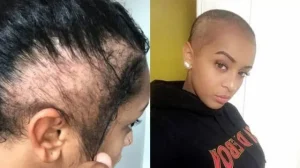This year’s Oscar was nothing but full of drama. Chris Rock, the comedian and host for the event, made jokes on Jada Pinkett Smith’s baldness on stage, and was subsequently slapped by her husband Will Smith.
Ms. Smith has a condition called alopecia – hair loss in simple words. It can affect our scalp or the entire body and could be either temporary or permanent. A study estimated that around 73% of Asian population has reported alopecia episode at least once in their life.

Figure 1. Jada Pinkett Smith
What are the symptoms?
Hair loss is usually most noticeable over the head. Here are some common types of hair loss presentations:
- Gradual hair thinning on top of the head: the most common form of hair loss associated with ageing. Usually it happens at bitemporal scalp in men and frontal scalp in women.
- Sudden hair loss: chemotherapy, radiotherapy and many medications can cause sudden hair loss. A sudden physical or emotional attack could also be the cause. However, this is usually temporary, and hair can grow back after the stimulus is gone.
- Full-body hair loss: like sudden hair loss, full-body hair loss can occur due to causes such as chemotherapy, radiotherapy and certain types of medications.
What are the causes?
Other than stress, medication and certain types of medical treatments, there are some other common causes of alopecia:
- Alopecia areata: an autoimmune condition that occurs when the body’s immune system attacks the hair follicles. Stress, environmental factors and genetics all play important roles in alopecia areata. It usually leads to small, circular patches of hair loss on the head. Some people develop this condition in their teenage years, but soon grow the hair back within 12 months without any medical intervention. Very little is understood about this condition.
- Hormone related: increased sensitivity or amount of androgen in the body’s circulation can cause hair loss in both males and females. Post-menopausal women, women with hyperandrogenism due to polycystic ovarian syndrome could both have such gradual nonscarring hair loss.
- Genetics: family history of age-related baldness, or androgenic baldness is the biggest risk factor of developing alopecia when you get older.
- Hairstyling: excessive hairstyling and treatments can cause traction alopecia. Pigtails or cornrows that pull your hair tight could speed up the process. If scarring occurs in the process, the hair loss could be permanent.
- Poor nutrition status: hair is made up of keratin – a type of protein makes up your hair, skin and nails. If people do not get enough protein intake through food, hair growth could be slowed down, accompanied by faster hair loss than normal.
Living with alopecia
There are still many social stigma surrounding alopecia. As a medical condition, it should not be joked around or made fun of. For patients living with alopecia, accepting and living with it can be hard, especially for females.
For people with androgenic alopecia, common medications including minoxidil and finasteride could slow down the process. For people with autoimmune alopecia areata, corticosteroids for inflammatory conditions could be of help. Hair transplant could also be considered. Talk to your general practitioner (GP) or dermatologist for more professional advice.
Remember, you are never alone on this. It can affect our self-esteem, confidence or mental health. Wigs could be a cosmetic solution and is considered by many with chronic hair loss problem. Also, do feel free to discuss your thoughts and feelings with a psychologist. There is always help and advice available.
